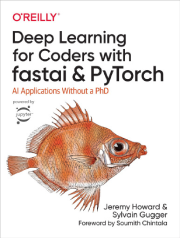
عنوان:
Deep Learning for Coders With Fastai and Pytorch
نویسنده:
Jeremy Howard, Sylvain Gugger
انتشارات:
Oreilly & Associates Inc
تاریخ انتشار:
2020
حجم:
10.3MB
معرفی کتاب:" آموزش یادگیری عمیق بدون نیاز به دکترای ریاضی با fastai و PyTorch"
یادگیری عمیق (Deep Learning) اغلب بهعنوان حوزهای انحصاری برای دارندگان مدرک دکترای ریاضی و شرکتهای بزرگ فناوری شناخته میشود. اما همانطور که این راهنمای عملی نشان میدهد، برنامهنویسانی که با زبان Python آشنایی دارند، میتوانند با داشتن دانش ریاضی اندک، دادههای کمحجم و کدنویسی حداقلی، به نتایج چشمگیری در حوزه یادگیری عمیق دست پیدا کنند.
چگونه؟ با استفاده از fastai، نخستین کتابخانهای که یک رابط کاربری منسجم برای رایجترین کاربردهای یادگیری عمیق فراهم میکند.
نویسندگان، Jeremy Howard و Sylvain Gugger، به شما نشان میدهند چگونه میتوانید یک مدل را برای مجموعهای گسترده از وظایف با استفاده از fastai و PyTorch آموزش دهید. همچنین بهتدریج وارد مباحث تئوری یادگیری عمیق میشوید تا درک کاملی از الگوریتمهای پشتصحنه بهدست آورید.
آنچه در این کتاب یاد میگیرید:
- آموزش مدلها در حوزههای Computer Vision، Natural Language Processing، Tabular Data و Collaborative Filtering
- یادگیری جدیدترین تکنیکهای Deep Learning که در عمل بیشترین اهمیت را دارند
- بهبود دقت، سرعت و قابلیت اطمینان از طریق درک عملکرد مدلهای یادگیری عمیق
- کشف روشهایی برای تبدیل مدلها به Web Applications
- پیادهسازی الگوریتمهای Deep Learning از پایه برای درک عمیقتر
- در نظر گرفتن پیامدهای اخلاقی و مسئولیتپذیری در توسعه مدلها
فهرست مطالب
- Preface
- Foreword
- Part I. Deep Learning in Practice
- Chapter 1. Your Deep Learning Journey
- Deep Learning Is for Everyone
- Neural Networks: A Brief History
- Who We Are
- How to Learn Deep Learning
- The Software: PyTorch, fastai, and Jupyter (And Why It Doesn’t Matter)
- Your First Model
- Deep Learning Is Not Just for Image Classification
- Validation Sets and Test Sets
- A Choose Your Own Adventure Moment
- Questionnaire
- Chapter 2. From Model to Production
- The Practice of Deep Learning
- Gathering Data
- From Data to DataLoaders
- Training Your Model, and Using It to Clean Your Data
- Turning Your Model into an Online Application
- How to Avoid Disaster
- Get Writing!
- Questionnaire
- Chapter 3. Data Ethics
- Key Examples for Data Ethics
- Integrating Machine Learning with Product Design
- Topics in Data Ethics
- Identifying and Addressing Ethical Issues
- Role of Policy
- Conclusion
- Questionnaire
- Deep Learning in Practice: That’s a Wrap!
- Part II. Understanding fastai’s Applications
- Chapter 4. Under the Hood: Training a Digit Classifier
- Pixels: The Foundations of Computer Vision
- First Try: Pixel Similarity
- Computing Metrics Using Broadcasting
- Stochastic Gradient Descent
- The MNIST Loss Function
- Putting It All Together
- Adding a Nonlinearity
- Jargon Recap
- Questionnaire
- Chapter 5. Image Classification
- From Dogs and Cats to Pet Breeds
- Presizing
- Cross-Entropy Loss
- Model Interpretation
- Improving Our Model
- Conclusion
- Questionnaire
- Chapter 6. Other Computer Vision Problems
- Multi-Label Classification
- Regression
- Conclusion
- Questionnaire
- Chapter 7. Training a State-of-the-Art Model
- Imagenette
- Normalization
- Progressive Resizing
- Test Time Augmentation
- Mixup
- Label Smoothing
- Conclusion
- Questionnaire
- Chapter 8. Collaborative Filtering Deep Dive
- A First Look at the Data
- Learning the Latent Factors
- Creating the DataLoaders
- Collaborative Filtering from Scratch
- Interpreting Embeddings and Biases
- Bootstrapping a Collaborative Filtering Model
- Deep Learning for Collaborative Filtering
- Conclusion
- Questionnaire
- Chapter 9. Tabular Modeling Deep Dive
- Categorical Embeddings
- Beyond Deep Learning
- The Dataset
- Decision Trees
- Random Forests
- Model Interpretation
- Extrapolation and Neural Networks
- Ensembling
- Conclusion
- Questionnaire
- Chapter 10. NLP Deep Dive: RNNs
- Text Preprocessing
- Training a Text Classifier
- Disinformation and Language Models
- Conclusion
- Questionnaire
- Chapter 11. Data Munging with fastai’s Mid-Level API
- Going Deeper into fastai’s Layered API
- TfmdLists and Datasets: Transformed Collections
- Applying the Mid-Level Data API: SiamesePair
- Conclusion
- Questionnaire
- Understanding fastai’s Applications: Wrap Up
- Part III. Foundations of Deep Learning
- Chapter 12. A Language Model from Scratch
- The Data
- Our First Language Model from Scratch
- Improving the RNN
- Multilayer RNNs
- LSTM
- Regularizing an LSTM
- Conclusion
- Questionnaire
- Chapter 13. Convolutional Neural Networks
- The Magic of Convolutions
- Our First Convolutional Neural Network
- Color Images
- Improving Training Stability
- Conclusion
- Questionnaire
- Chapter 14. ResNets
- Going Back to Imagenette
- Building a Modern CNN: ResNet
- Conclusion
- Questionnaire
- Chapter 15. Application Architectures Deep Dive
- Computer Vision
- Natural Language Processing
- Tabular
- Conclusion
- Questionnaire
- Chapter 16. The Training Process
- Establishing a Baseline
- A Generic Optimizer
- Momentum
- RMSProp
- Adam
- Decoupled Weight Decay
- Callbacks
- Conclusion
- Questionnaire
- Foundations of Deep Learning: Wrap Up
- Part IV. Deep Learning from Scratch
- Chapter 17. A Neural Net from the Foundations
- Building a Neural Net Layer from Scratch
- The Forward and Backward Passes
- Conclusion
- Questionnaire
- Chapter 18. CNN Interpretation with CAM
- CAM and Hooks
- Gradient CAM
- Conclusion
- Questionnaire
- Chapter 19. A fastai Learner from Scratch
- Data
- Module and Parameter
- Loss
- Learner
- Conclusion
- Questionnaire
- Chapter 20. Concluding Thoughts
- Appendices
- A. Creating a Blog
- B. Data Project Checklist
- Index
مشخصات
نام کتاب
Deep Learning for Coders With Fastai and Pytorch: Ai Applications Without a Phd
نویسنده
Jeremy Howard, Sylvain Gugger
انتشارات
Oreilly & Associates Inc
تاریخ انتشار
2020
ISBN
9781492045526
تعداد صفحات
1109
زبان
انگلیسی
فرمت
حجم
10.3 MB
موضوع
Deep Learning
